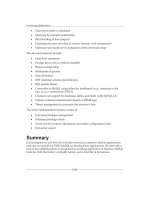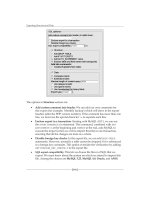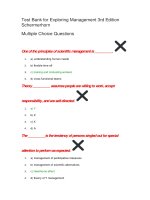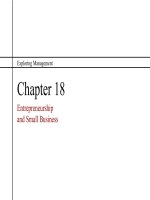Exploring management 3rd ch04
Bạn đang xem bản rút gọn của tài liệu. Xem và tải ngay bản đầy đủ của tài liệu tại đây (555.03 KB, 31 trang )
Exploring Management
Chapter 4
Managers as
Decision Makers
Chapter 4
• How do managers use information to
solve problems?
• What are the five steps in the decisionmaking process?
• What are some current issues in
managerial decision making?
4.1
Using Information to Solve Problems
• Managers deal with problems posing threats and
offering opportunities.
• Managers can be problem avoiders, problem
solvers, or problem seekers.
• Managers make programmed and
nonprogrammed decisions when solving
problems.
• Managers can use systematic and intuitive
thinking.
4.1 Continued
Using Information To Solve Problems
• Managers use different cognitive styles to
process information for decision making
• Managers make decisions under
conditions of certainty, risk, and
uncertainty.
USING INFORMATION TO Solve Problems
Problems Pose Threats And Opportunities
• Problem Solving
– Identifying and taking action to solve problems.
• Knowledge Workers
– Use information to solve problems, describes managers well.
• Performance Threat
– A situation where something is wrong or likely to be wrong.
• Performance Opportunity
– A situation that offers the possibility of a better future, if the
right steps are taken.
USING INFORMATION TO Solve Problems
Problems Pose Threats And Opportunities
USING INFORMATION TO Solve Problems
Problem Solving Approaches
• Problem avoiders – prefer not to make
decisions and ignore problems
• Problem solvers – react to problems as
they occur
• Problem seekers – proactive in
anticipating threats and opportunities
USING INFORMATION TO SOLVE PROBLEMS
Types of Decisions
• Programmed decisions
–
applies a solution from past experience to
a routine problem
• Non-programmed decisions
–
applies a specific solution crafted for a
unique problem
USING INFORMATION TO SOLVE PROBLEMS
Problem Solving Approaches
• Systematic Thinking
– Approaches problems in a rational and
analytical fashion.
• Intuitive Thinking
– Approaches problems in a flexible and
spontaneous fashion.
USING INFORMATION TO SOLVE PROBLEMS
Problem Solving Approaches
Managers use
different
cognitive
styles
Sensation
Thinkers
impersonal,
realistic, prefer
facts
Intuitive Feelers
relationship
oriented,
abstract, flexible
Intuitive Thinkers
impersonal,
abstract,
idealistic, likes
unstructured
problems
Sensation Feelers
relationship
oriented,
analytical,
realistic
USING INFORMATION TO SOLVE PROBLEMS
Problem Solving Environments
Managers make decisions with various
amounts of information
Certain environment
• offers complete information on possible action
alternatives and their consequences
Risk environment
• lacks complete information but offers probabilities of
the likely outcomes for possible action alternatives
Uncertain environment
• lacks so much information that it is difficult to assign
probabilities to the likely outcomes of alternatives
USING INFORMATION TO SOLVE PROBLEMS
Problem Solving Environments
4.2
Steps In The Decision Making Process
Step 1 is to identify and define the problem.
Step 2 is to generate and evaluate
alternative courses of action.
Step 3 is to decide on a preferred course of
action.
Step 4 is to implement the decision.
Step 5 is to evaluate results.
4.2
Steps In The Decision Making Process
THE DECISION MAKING PROCESS
Step 1 – Identify And Define The Problem
• Gather information and decide what should be
accomplished
• Common mistakes include
– Identifying the problem too broadly
– Dealing with symptoms rather than problems
– Choosing the wrong problem
THE DECISION MAKING PROCESS
Step 2 – Generate And Evaluate Alternatives
• Who are the stakeholders and how will the
alternatives affect them?
• Criteria for evaluating alternatives
– Cost benefit analysis
– Timeliness
– Acceptability
– Ethical soundness
THE DECISION MAKING PROCESS
Step 3 – Decide On A Preferred Course Of Action
• Two different outcomes
– Behavioral model leads to satisficing decisions
– Classical model leads to optimizing decisions
THE DECISION MAKING PROCESS
Step 4 – Implement The Decision
• Take action on the selected alternative
• Lack of participation error occurs when
parties necessary for supporting the
decision were not included in the process
THE DECISION MAKING PROCESS
Step 5 – Evaluate Results
• Did the decision solve the problem?
• Results must be evaluated against
objectives set at the beginning of the
process.
Utility
• Does the decision satisfy all
constituents or stakeholders?
Rights
• Does the decision respect the
rights and duties of everyone?
Justice
• Is the decision consistent with
the canons of justice?
Caring
• Is the decision consistent with
my responsibilities to care?
• Ethical reasoning
Make the ethics “double check”.
Ethical Reasoning Is Important
THE DECISION MAKING PROCESS
THE DECISION MAKING PROCESS
Ethical Reasoning Is Important
• Spotlight questions
– How would I feel if my family found
out about this decision?
– How would I feel if this decision were
published in the local newspaper or
posted on the Internet?”
– What would the person I know who
has the strongest character and best
ethical judgment say about my
decision?”
4.3
Current Issues In Decision Making
• Personal factors help drive creativity in
decision making.
• Group decision making has both advantages
and disadvantages.
• Judgmental heuristics and other biases and
traps may cause decision-making errors.
• Managers must be prepared for crisis
decision making.
ISSUES IN DECISION MAKING
Personal Factors Drive Creativity
Task
Motivation
Task
Expertise
Creativity
Skills
Creativity
ISSUES IN DECISION MAKING
Personal Factors Help Drive Creativity
• Creativity – generating a novel idea or
unique approach
• Personal creativity drivers
– Task expertise is expanding an existing skill
– Task motivation is the drive to work hard
– Creativity skills include imagination, intuition,
holistic processing, right brain characteristics
ISSUES IN DECISION MAKING
Group Decision Making
Why group decisions are often good:
Why group decisions can be bad:
• More information, expertise, and
viewpoints are available to help
solve problems.
• More alternatives More alternatives
are generated and considered
during decision making.
• Increased understanding There is
increased understanding and greater
acceptance of decision by group
members.
• Greater commitment There is
increased commitment of group
members to work hard and support
the decision.
• Conformity with social pressures
Some members feel intimidated by
others and give in to social pressures
to conform.
• Domination by a few members A
minority dominates; some members
get railroaded by small coalition of
others.
• Time delays More time is required to
make decisions when many people
try to work together.
• A crisis is an unexpected problem
that can lead to disaster if not
resolved quickly and appropriately.









